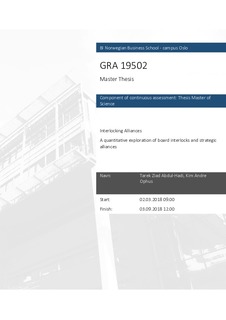Interlocking Alliances : A quantitative exploration of board interlocks and strategic alliances
Master thesis
Permanent lenke
http://hdl.handle.net/11250/2579114Utgivelsesdato
2018Metadata
Vis full innførselSamlinger
- Master of Science [1621]
Sammendrag
This study explores the relationship between board interlocks and strategic
alliances. Our introduction identifies the abovementioned link as an overlooked
relationship and justifies the reasoning behind this study. Our theoretical
framework introduces the notion that a board interlock has potential benefits for
strategic alliances. Specifically, we study the influence of board members’ ties to
external firms on the alliance participation propensity of the focal firm. Moreover,
we identify alliances where the partners share a board member and define alliances
with this characteristic as interlocking alliances. Finally, we study the effect of this
characteristic on the alliance performance in terms of abnormal returns accruing to
the partners.
We find that an expansion of the board by one member increase the propensity of
alliance participation by 3 %. We also find that an increase by one additional board
interlock increase the propensity of alliance participation by 3 %. The search of
interlocking alliances resulted in five observations, suggesting this as a rare
occurrence. Due to the small sample size, the performance measurements did not
hold any statistical significance. However, the observed abnormal returns were
fluctuating between negative and positive.
Implications of these findings for the literatures on board interlocks and strategic
alliances are discussed. Our study contributes to the strategic management literature
by the identification of interlocking alliances, the effect of the board on alliance
participation propensity, and by drawing the overlooked link between board
interlocks and strategic alliance performance.
Beskrivelse
Masteroppgave(MSc) in Master of Science in Business, Strategy - Handelshøyskolen BI, 2019
